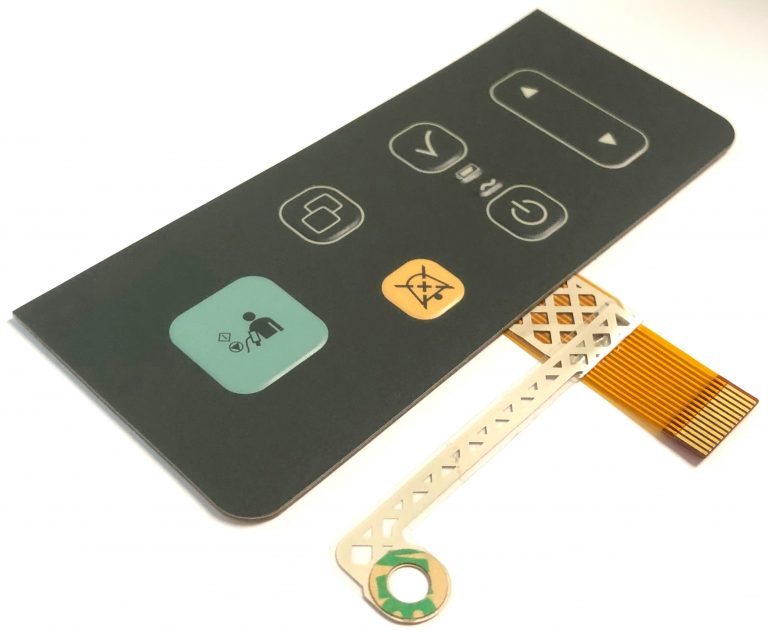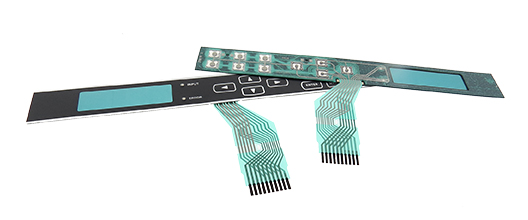The Production Process Behind Membrane Layer Switch: What You Need to Know
The production procedure behind membrane layer switches over combines careful design, product selection, and quality control. It starts with comprehending the intricacies of membrane layer switch style and progresses with various phases, consisting of material selections and printing methods. Each stage plays a necessary role in guaranteeing functionality and sturdiness. The complexities of layer building and construction and the rigorous screening requirements may disclose insights that are not immediately evident. What exists past these foundational components?
Recognizing Membrane Change Design
Although membrane layer switches may appear basic at first glance, their style entails intricate considerations that guarantee performance and longevity. The style procedure starts with a complete understanding of customer needs, consisting of the interface's desired application and ecological variables. Functional designs is a crucial element, as the format has to facilitate ease of usage while ensuring that responsive comments satisfies individual expectations.Moreover, the layering of elements, such as graphic overlays, adhesive layers, and conductive traces, should be precisely engineered. membrane switch. This split configuration not only influences the button's responsiveness yet likewise affects its longevity. Attention is provided to the sealing techniques employed to shield versus wetness and dust, which can endanger efficiency. In addition, style considerations include aesthetic appeals, where color pattern and aesthetic clearness improve individual experience. Ultimately, the layout of membrane switches equilibriums performance, user experience, and durability, guaranteeing that they meet the needs of different applications effectively
Products Used in Membrane Layer Change Production
When selecting products for membrane button manufacturing, it is essential to ponder both performance and longevity. The key materials consist of polyester and polycarbonate films, which supply flexibility and strength. These films are typically covered with sticky to assure proper bonding to substratums. Conductive inks, commonly composed of silver or carbon, are critical for creating electrical links within the button, permitting for trustworthy operation.Additionally, a protective layer, such as a tough layer, is regularly put on improve scrape resistance and durability. The selection of backing material, such as acrylic or foam, can significantly impact the button's tactile feeling and overall individual experience. Moreover, different ecological factors, including temperature and moisture, should direct product option to guarantee peak performance in details applications. Ultimately, the right combination of products adds to the membrane switch's performance and life-span, making educated choices important for makers.
The Printing Refine: Creating Video and Text
The printing process in membrane switch manufacturing plays a significant role in creating premium graphics and message. Numerous visuals layout strategies are used to assure aesthetic allure and capability, while mindful ink option approaches are crucial for durability and performance. Recognizing these components is basic for attaining finest lead to membrane layer switch design.
Graphic Style Techniques
Graphic style techniques play an important role in the printing procedure of membrane switches, as they specify exactly how graphics and text will inevitably appear on the final item. Efficient graphic layout includes the strategic usage of typefaces, shades, and layouts to improve readability and aesthetic charm. Developers typically utilize vector graphics for scalability, making certain that pictures remain sharp at different dimensions. Furthermore, focus to contrast and placement is important, as it affects user communication and aesthetic high quality. The unification of branding aspects, such as logo designs, must be managed with like maintain brand name integrity. Generally, thoughtful visuals design methods add considerably to the performance and attractiveness of membrane buttons, impacting user experience and item efficiency.
Ink Selection Methods
Choosing the ideal ink is important for achieving the desired visual high quality and resilience in membrane switch manufacturing. Various ink types are used, including solvent-based, water-based, and UV-curable inks. Each kind supplies distinct qualities, such as adhesion, versatility, and resistance to environmental elements. Solvent-based inks are typically preferred for their longevity and vibrant colors, while water-based inks are more eco-friendly however may have restrictions in bond. UV-curable inks offer rapid curing and robust performance. In addition, shade matching strategies assure that the chosen inks line up with style specs. Ultimately, the choice of ink must consider elements such as application method, substrate compatibility, and end-use needs to attain remarkable lead to membrane switch graphics and message.
Layer Building And Construction and Setting Up

Product Option Process
A careful choice of materials is necessary in the production procedure of membrane layer buttons, as it straight affects capability and sturdiness. The main materials utilized consist of polyester, polycarbonate, and different conductive inks. Polyester is usually preferred for its superb resistance to chemicals and abrasion, making it ideal for harsh environments. Polycarbonate, on the other hand, provides exceptional clarity and impact resistance, which is advantageous for applications needing visibility and robustness. Conductive inks, generally composed of silver or carbon, are crucial for producing trustworthy electric paths. Furthermore, the option of adhesive materials influences the total stability of the switch - membrane switch. Evaluating factors such as ecological direct exposure, tactile feedback, and visual demands guides manufacturers in picking the most effective materials for their certain applications
Layer Adhesion Strategies
Sticking layers in membrane button building is a crucial procedure that guarantees functionality and long life. Different bond techniques home are used to protect optimal bonding between layers, which commonly consist of using adhesives, warmth, and pressure. Pressure-sensitive adhesives (PSAs) are frequently used for their ease of application and prompt bonding capabilities. In addition, thermal bonding methods can be used, where warm is used to trigger adhesive homes, securing a solid bond. The choice of bond approach mainly relies on the materials entailed and the particular application needs of the membrane layer button. Appropriate placement and uniform application of adhesives are important to avoid issues, securing the button runs efficiently throughout its designated life expectancy.
Quality Assurance Steps
Assuring quality control during the layer building and construction and setting up of membrane switches is crucial for maintaining efficiency and dependability. This process generally involves numerous important measures, including extensive examinations at each stage of production. Makers make use of advanced testing methods, such as peel tests and bond evaluations, to confirm the honesty of layer bonds. In addition, aesthetic inspections are conducted to determine any type of flaws in printing or product incongruities. Ecological conditions, such as temperature and humidity, are thoroughly kept an eye on to ensure optimal treating and bond. Normal calibration of devices assists preserve accurate manufacturing standards. By implementing these quality assurance steps, producers can significantly reduce the risk of item failing, ensuring that the final membrane layer switches over satisfy the called for specs and client expectations.
Testing and Top Quality Control Procedures

Innovations in Membrane Layer Change Technology
As advancements in modern technology remain to evolve, membrane layer switches are taking advantage of cutting-edge advancements that enhance their capability and individual experience. One notable advancement is the combination of capacitive touch modern technology, which permits even more intuitive and receptive individual interfaces. This change not just enhances looks however additionally lowers mechanical wear and tear, expanding try this site the life expectancy of the switches.Additionally, advancements in visuals overlay products have brought about enhanced durability and resistance to environmental variables such as wetness and UV light. These materials now supply enhanced clearness and illumination, further boosting the aesthetic appeal.Furthermore, the consolidation of clever technology is transforming membrane layer switches into interactive control board, enabling connectivity with IoT gadgets. This connection fosters a seamless customer experience, leading the way for applications in different sectors, from healthcare to consumer electronic devices. Jointly, these innovations position membrane changes as critical components in contemporary gadget layout.
Regularly Asked Questions
For how long Does the Membrane Switch Over Production Process Take?
The duration of the membrane layer switch manufacturing process can vary substantially. Factors such as complexity, materials used, and production volume influence timelines, with common manufacturing ranging from a few days to a number of weeks for conclusion.
What Are the Usual Applications for Membrane Layer Buttons?
Membrane layer buttons are generally made use of in numerous sectors, consisting of auto controls, house devices, clinical tools, and consumer electronics (membrane switch). Their adaptability and longevity make them ideal for applications calling for straightforward user interfaces and trustworthy efficiency in diverse environments
Can Membrane Switches Over Be Custom-made for Details Demands?

What Is the Life-span of a Typical Membrane Change?
The life-span of a typical membrane switch varies, but typically, it ranges from 1 to 5 million cycles. Elements such as usage, atmosphere, and worldly high quality substantially affect durability and overall performance in time.

Are Membrane Layer Changes Ecologically Friendly?
The environmental friendliness of membrane switches over differs. Some products utilized may not visit this website be recyclable, while others can be environmentally friendly. The overall influence relies on producing methods and materials, requiring careful consideration throughout choice and disposal. The manufacturing procedure behind membrane layer changes combines careful layout, product selection, and quality control. It starts with comprehending the intricacies of membrane layer switch design and proceeds with various phases, including product options and printing techniques. When picking materials for membrane layer switch manufacturing, it is crucial to consider both performance and toughness. A careful selection of materials is essential in the manufacturing process of membrane switches, as it straight influences functionality and sturdiness. The choice of adhesion method largely depends on the materials entailed and the details application requirements of the membrane button.